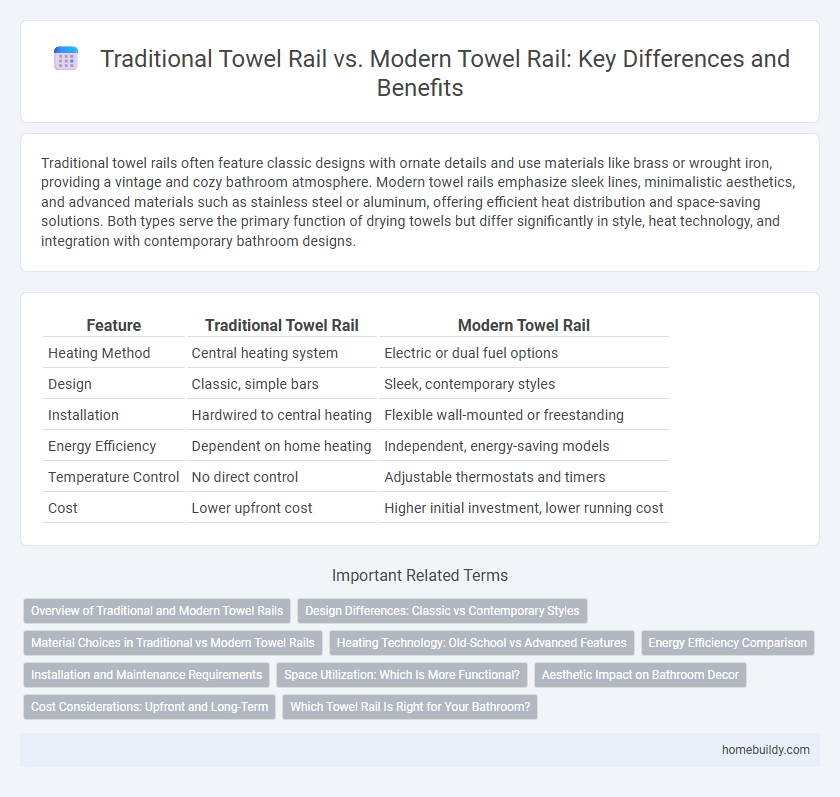Traditional towel rails often feature classic designs with ornate details and use materials like brass or wrought iron, providing a vintage and cozy bathroom atmosphere. Modern towel rails emphasize sleek lines, minimalistic aesthetics, and advanced materials such as stainless steel or aluminum, offering efficient heat distribution and space-saving solutions. Both types serve the primary function of drying towels but differ significantly in style, heat technology, and integration with contemporary bathroom designs.
Table of Comparison
| Feature | Traditional Towel Rail | Modern Towel Rail |
|---|---|---|
| Heating Method | Central heating system | Electric or dual fuel options |
| Design | Classic, simple bars | Sleek, contemporary styles |
| Installation | Hardwired to central heating | Flexible wall-mounted or freestanding |
| Energy Efficiency | Dependent on home heating | Independent, energy-saving models |
| Temperature Control | No direct control | Adjustable thermostats and timers |
| Cost | Lower upfront cost | Higher initial investment, lower running cost |
Overview of Traditional and Modern Towel Rails
Traditional towel rails typically feature classic designs made from materials like chrome or brass, emphasizing decorative appeal and warmth retention through electric or hydronic heating systems. Modern towel rails prioritize sleek, minimalist aesthetics using stainless steel or aluminum, incorporating energy-efficient technologies such as digital controls or dual-fuel options. Both types serve the primary purpose of drying and warming towels but differ significantly in design, heating efficiency, and integration with contemporary bathroom fixtures.
Design Differences: Classic vs Contemporary Styles
Traditional towel rails feature ornate detailing with curved bars and warm metallic finishes such as brass or bronze, evoking a vintage, classic aesthetic. Modern towel rails emphasize sleek lines, minimalist forms, and materials like stainless steel or matte black, complementing contemporary bathroom designs. The design differences highlight traditional rails as decorative focal points, while modern versions prioritize functionality and subtle integration.
Material Choices in Traditional vs Modern Towel Rails
Traditional towel rails often feature materials like wrought iron, brass, or chrome-plated steel that provide durability and a classic aesthetic. Modern towel rails commonly use stainless steel, aluminum, or even eco-friendly composites, offering lightweight, corrosion-resistant, and energy-efficient properties. The choice of materials directly impacts heat conduction, design flexibility, and maintenance requirements in both traditional and contemporary bathroom settings.
Heating Technology: Old-School vs Advanced Features
Traditional towel rails rely on basic convection heating, often powered by central heating systems, which provides consistent warmth but lacks energy efficiency and flexibility. Modern towel rails incorporate advanced heating technology such as electric elements with thermostatic controls, programmable timers, and quick heat-up capabilities, offering precise temperature management and energy savings. These innovative features enhance user comfort while reducing operational costs compared to old-school models.
Energy Efficiency Comparison
Traditional towel rails typically rely on electrical resistance heating, which tends to consume more energy due to slower heat distribution and longer warm-up times. Modern towel rails often incorporate advanced technologies such as hydronic systems or low-wattage electric elements combined with improved insulation, significantly enhancing energy efficiency while maintaining optimal warmth. Energy-saving features, including programmable timers and smart thermostats, are more commonly integrated into modern towel rails, reducing overall power consumption compared to their traditional counterparts.
Installation and Maintenance Requirements
Traditional towel rails typically require more complex installation involving wall mounting and plumbing for heated models, often necessitating professional assistance. Modern towel rails offer simpler installation options such as plug-in electric models or freestanding designs, reducing the need for extensive wiring or plumbing work. Maintenance for traditional rails includes regular inspection of plumbing connections to prevent leaks, while modern rails generally require minimal upkeep, primarily focused on cleaning and occasional electrical safety checks.
Space Utilization: Which Is More Functional?
Traditional towel rails often feature fixed, horizontal bars that require ample wall space, limiting their functionality in compact bathrooms. Modern towel rails utilize vertical or multi-tier designs, maximizing space by allowing for multiple towels to be hung simultaneously without occupying large wall areas. This vertical orientation enhances drying efficiency and optimizes limited bathroom space, making modern towel rails more functional for contemporary small-scale living environments.
Aesthetic Impact on Bathroom Decor
Traditional towel rails feature classic designs and materials like brass or wrought iron, adding a timeless elegance and vintage charm that complements rustic or traditional bathroom decor styles. Modern towel rails often incorporate sleek lines, minimalist shapes, and contemporary materials such as stainless steel or matte black finishes, enhancing a bathroom's modern, clean, and sophisticated aesthetic. Choosing between traditional and modern towel rails significantly influences the overall ambiance and style coherence of the bathroom space.
Cost Considerations: Upfront and Long-Term
Traditional towel rails generally have lower upfront costs due to simpler designs and basic materials, making them a budget-friendly option for initial installation. Modern towel rails, though often more expensive initially because of advanced features like integrated heating and sleek finishes, offer improved energy efficiency that reduces long-term operating expenses. Considering both purchase price and ongoing energy savings is essential when comparing the total cost of traditional versus modern towel rails.
Which Towel Rail Is Right for Your Bathroom?
Traditional towel rails often feature classic designs with materials like brass or chrome, providing a timeless aesthetic and reliable heat output for cozy bathroom warmth. Modern towel rails incorporate sleek finishes, innovative materials such as stainless steel or aluminum, and advanced heating technologies, offering energy efficiency and faster drying times. Choosing the right towel rail depends on your bathroom's style, heating needs, and energy preferences to balance functionality with decor.
Traditional towel rail vs modern towel rail Infographic

 homebuildy.com
homebuildy.com